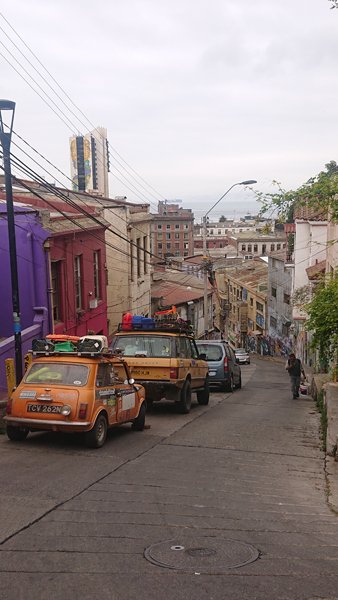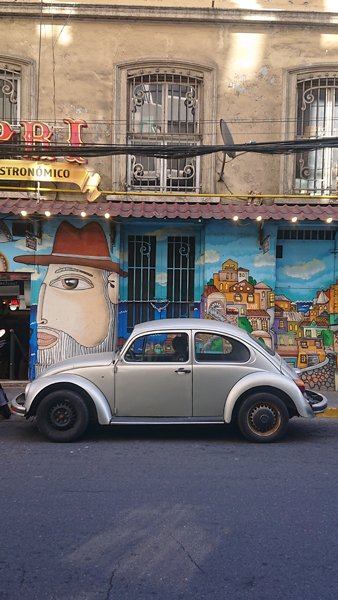Down But Not Out: Mini 6000 Expedition Leg 6
Daisy and the team make their descent after reaching great heights.
When you’re 5,920 metres up, on the side of the world’s highest volcano, all roads lead down. Or at least they would, if there were any roads up there. According to Guinness World Records, the highest road in the world is the Umling Pass in northern India, coming in at a lofty 5,798 metres. Or to put it another way, over 120 metres below where our 50 year-old Mini found itself as 2024 began. So, down we went.
We’d already rolled and bounced the Mini a short way down the mountain, after the engine failed to start on the steep slope at its highpoint, and with the car now on safe, level ground, we set about getting the engine running. It took quite a while, such was the effect of the thin air almost six kilometres above sea level, way outside what the carburettor was designed for. The Range Rover was suffering too, its fuel injection unable to run lean enough to provide a combustible mixture on start-up. But eventually, we got both of the cars running, loaded them up with our kit, and started down.
The Mini took the descent in its stride, seemingly psyched to return to the thicker air lower down. Whereas on the way up, its lack of traction on the soft sand, and lack of power in the thin air had made the journey a struggle, bouncing its way down through the sand and rocks it performed wonderfully, with its extra ground clearance and nimble handling enabling it to thread a line down the mountain where usually, only the occasional 4x4 will tread. Within only a few hours, we’d dropped down from our highest camp at 5,840 metres, to the climber’s Refugio Atacama, 5,250 metres above sea level, all in a distance of only six kilometres. The Mini had only got stuck once in the process, beached on soft sand which lifted the wheels clean off the ground. The Range Rover, meanwhile, took the descent nonchalantly and ran far happier as altitude was lost.
Following an overnight stop at 5,250 metres, the next stage of the descent beckoned, to where tarmac began at 4,450 metres. Again, the Mini performed far more competently than on the way up, bouncing through the rocks and only having issues when faced with its ultimate nemesis – soft sand. Following one last tow from the Range Rover, it was through. The track firmed up, corrugations formed, and the familiar outlines of the mountains we’d left weeks earlier reappeared, rising up above the tarmac road, to which returning to was an almost blissful moment. Four kilometres lower and 250 kilometres to the west, the town of Copiapo was waiting for us. We set off with enthusiasm, savouring the thought of our first proper meal in almost a month. And beer. Beer appealed too, of course.
But it wasn’t the easiest drive. Crossing a 4,000 metre pass while temporarily back on gravel, the Mini’s top radiator hose split. It also developed a misfire as the air thickened, throwing our carburettor’s settings out of sync. The Range Rover’s overheating also made a periodic return, along with the leak from the freeze plug. But these were small issues compared to what we’d already overcome, and that evening we were back in the world we’d left behind weeks before. A world of buildings, people and luxuries, such as beds, bars, clean clothes and flushing toilets. Already, the thin air and wind-borne sands of altitude was fading to memory.
We spent two nights in Copiapo readjusting, before the drive continued south. The Atacama didn’t want to release us just yet, and both cars suffered overheating issues as they hauled their occupants and all our mountain equipment up the long inclines of Chile’s Ruta Five, beneath the blazing desert sun. Despite the smooth tarmac beneath our wheels, the easy run out of the desert which we’d hoped for didn’t materialise. For hour after hour we rolled on slowly, many of the passing Chileans showing their appreciation for the Mini with a beep and a wave as they passed.
Gradually the landscape changed, the colour green began to make a return, as vegetation reappeared, trees and grasses encroaching on the endless sands. Then the Pacific Ocean swept in from the right, its shimmering blueness a shock for eyes so used to the near-monochrome world of the volcano’s slopes.
We spent our nights by the sea, either camping or in cheap rooms, as our lives slowly returned to those of conventional overlanders. Days began with coffee and a thorough check of the cars, proceeded through the day’s mileage, before ending with a search for somewhere to stay, and food to eat. There were parts of our experience which differed from that of most people on the road, though – the welcome we received from Chile’s vibrant Mini community, for instance. In the course of our drive we received many invites to visit fellow car enthusiasts, but such was the time pressure having come down from the mountain late, we seldom had the chance to stop.
However on one occasion, in the town of Ovalle, we met up with some fellow enthusiasts at a garage, and were shown a very warm welcome. Minis were built in northern Chile in the 1960s, uniquely with fibreglass body shells, and so the car is appreciated as part of the nation’s culture. They aren’t exactly a common sight on the roads, but everyone recognises them, and there’s a vibrant group of owners who keep the memories alive – and from our experience of meeting some of them, they’re a great group of people.
From Ovalle, we carried on down the coast, our last stop on the shores of the Pacific being the town of Valpaiso. This unique place drips down the steepest of hillsides, and every inch of it seems decorated with a vibrant brand of graffiti. Grungy, bohemian and beguiling, it’s the sort of place you either love or hate. The only way to know for sure is to see it for yourself.
While we were seeing the place for ourselves, we kept on glancing west across the rooftops, to the bay where cargo ships drifted in from the ocean. It was to be our last glance of the Pacific – the cars needed to be shipped home, and we had to head to the Atlantic to facilitate this.
For the second time in two months, it was time to drive clean across South America, this time west to east. But that’s a story for the next update.
Words & Photography Ben Coombs Twitter/X | Instagram
















The Mini 6000 Expedition ends with a lengthy drive back to the Atlantic coast.